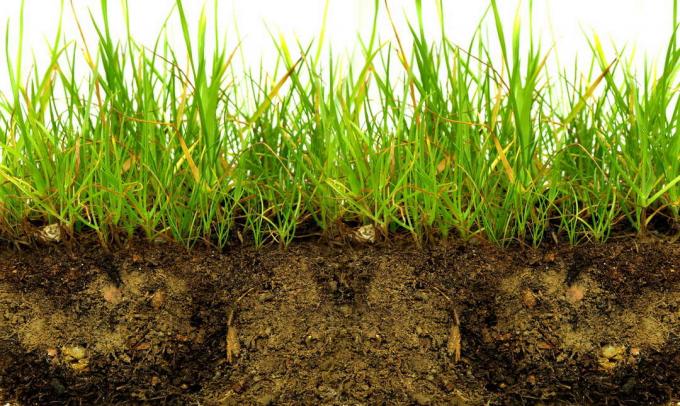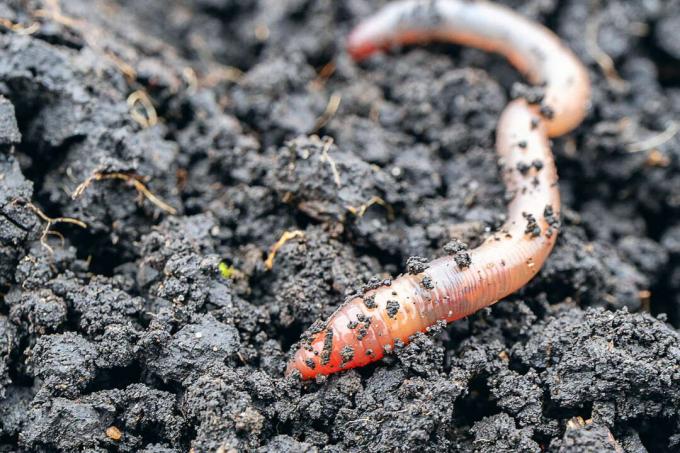For a lush green, the lawn must be properly fertilized. Here you can find out why you should use organic lawn fertilizer.

Both the ingredients and the effect of organic and mineral lawn fertilizers differ from each other. With the right lawn care, you not only influence the appearance of your lawn this year lawn, but also its ability to survive the winter and the ground beneath it Root. We will inform you about organic lawn fertilizers so that you can make the right choice when shopping.
contents
-
Organic lawn fertilizer: ingredients and effects
- Ingredients of organic lawn fertilizer
- Effect of organic lawn fertilizers
- Organic autumn lawn fertilizer
- A comparison of organic and mineral lawn fertilizers
- Buy organic lawn fertilizer
Organic lawn fertilizers promise lawn care with a clear conscience. But some people claim that a vigorous lawn cannot be achieved with such “eco stuff”. In this article, you can learn why the natural way can also be the most effective.
Organic lawn fertilizer: ingredients and effects
How do the ingredients in an organic lawn fertilizer differ from those in a mineral lawn fertilizer? The nutrient elements are not pure, but built into organic structures, which of course influences the effect of the fertilizer.
Ingredients of organic lawn fertilizer
Organic lawn fertilizers contain the nutrients important for the lawn in an organically packaged form. This "packaging" can be of animal or vegetable origin: many organic fertilizers are made from slaughterhouse waste such as blood, horn and bones. However, purely plant-based raw materials that are produced in the food industry are also being used more and more frequently. Animal excrement in dried form is also often used.

Basically, an organic fertilizer contains all the nutrient elements that the living being contained in it has absorbed in order to be able to live. Accordingly, all the nutrients that plants need are also present in a lawn fertilizer made from plants. Of course, the amount can vary - depending on which part of the creature was used. Fertilizer manufacturers vary the composition of the starting materials in such a way that the needs of a wide variety of crops can be satisfied. The nutrient elements nitrogen (N), phosphorus (P), potassium (K), magnesium (Mg), sulfur (S) and calcium (Ca) in lawn fertilizers are adapted to the needs of the lawn. The trace nutrients iron (Fe), zinc (Zn), molybdenum (Mo), manganese (Mn), boron (B), chlorine (Cl), nickel (Ni) and copper (Cu) are only required in very small amounts. Therefore, they are hardly considered in fertilizer production, but are always present in traces. Since lawns have an increased need for nitrogen, potassium and magnesium, these nutrient elements are particularly well represented in organic lawn fertilizers.
Effect of organic lawn fertilizers
The effect of organic lawn fertilizer corresponds to the natural nutrient supply of plants. Because unlike fertilization with mineral fertilizers, the plant nutrients must first be freed from their organic shell in order to be available. The conversion of organic material into mineral nutrients can only be carried out by soil organisms. This is a biological process. Worms, insects and other multicellular soil dwellers take over the coarse crushing. Soil bacteria then set to work to process structures at the cellular level. Since the work of the soil organisms takes a certain amount of time, the effect of organic lawn fertilizers sets in with a slight delay, within a month of application. This is followed by a phase of steady release until the nutrients contained are used up. So there is a natural long-term effect.

Since the soil organisms are influenced by their environment, the implementation always depends on the weather. Humidity, warmth and an oxygen-rich soil promote the conversion. On the other hand, they are inhibited by cold and too wet, low-oxygen soil. However, this fact is by no means a disadvantage: in this way there are always many nutrients available even if the weather is “growing” for the fertilized lawn and it has a lot of nutrients needed. More to organic fertilizers in general see here.
Tip: In addition to the so-called mineralization, i.e. the release of nutrients from organic material, another process can take place at the same time: humification. In the absence of microbial activity, the material is not degraded, but only broken down and modified. The breakdown is followed by the build-up of so-called humic acids, which form the basis for humus. More to formation of humus and the influencing factors can also be found in this special article.
Summary of effects and ingredients of organic lawn fertilizer:
- Organic Lawn Fertilizer contains nutrients in a natural package
- In addition to the main nutrients that are particularly important for the lawn, it also contains trace elements
- The release of nutrients depends on soil organisms
- The living conditions of the organisms influence the release
- Organic lawn fertilizer has a natural long-term effect
- In addition to the release of nutrients, humus can also form
Organic autumn lawn fertilizer
Organic fertilizers are also suitable for preparing the lawn for winter. However, organic autumn lawn fertilizers are no longer nitrogen-rich, but potassium-rich, because potassium ensures a high frost tolerance. Lowering the nitrogen content prevents freshly sprouting stalks from falling victim to the often already cold autumn temperatures. When temperatures drop, the release of nutrients stops, preventing leaching or incorrect fertilization. If the next spring brings permanently warmer temperatures, the release of the nutrients will slowly start again and can thus promote a strong spring shoot of the lawn. All of these properties of organic fertilizers make them a particularly good choice for autumn lawn maintenance. Here you can find information on the correct Lawn fertilization in autumn and at this point you will find out all about our Plantura Organic Autumn Lawn Fertilizer.

Summary: Organic autumn lawn fertilizer
- Fall lawn fertilizers are low in nitrogen and high in potassium
- Both protect the lawn from frost damage
- Organic autumn lawn fertilizers protect against leaching and incorrect fertilization before winter and can promote spring growth
A comparison of organic and mineral lawn fertilizers
The use of mineral lawn fertilizers is preferred by many more or less professional gardeners. At first glance, this has advantages: the low price, the high nutrient content and the immediate effect make bargain hunters and impatient people sit up and take notice. In order to clear up these supposed advantages, we have compared organic and mineral lawn fertilizers for you.
Benefits of Organic Lawn Fertilizer
| aspect | Organic Lawn Fertilizer... | Mineral lawn fertilizers... |
|---|---|---|
| soil life | stimulate the diversity and activity of soil life, which improves soil structure. | reduce the diversity and activity of soil life, which degrades soil structure. |
| humus content | ensure the preservation or even the formation of humus, which increases your nutrient and water storage capacity. | lead to humus degradation due to the high nutrient content, and the soil quality decreases. |
| over-fertilization and leaching | only provide nutrients when the weather is growing. This avoids over-fertilization and leaching. | provide nutrients regardless of the weather, making over-fertilization and leaching of nutrients into groundwater more likely. |
| long-term effect | have a natural long-term effect. | short-acting unless manufactured as a slow release fertilizer. In this case they are more expensive. |
| speed of action | have a delayed effect, but slow implementation promotes steady growth. | act very quickly, which often results in intermittent growth. |
| manufacturing | are less energy-intensive to produce and use leftovers from the food industry. | are produced with high energy requirements or mined in partially limited fossil deposits. |
| soil chemistry | correspond to the natural nutrient supply of plants, which keeps the soil chemistry in balance. | bypass several steps in the complex, natural nutrient supply of the soil, which can lead to undesirable changes in pH and thus the fixation of plant nutrients. |
| nutrient | In addition to the declared nutrients, they also contain important trace nutrients. | contain only the specified nutrients, so that at some point a lack of trace nutrients can occur. This is often difficult to identify. |
| price | are more expensive in the short term, but save on later soil improvement measures and usually reward the user with healthier plants, less frequent watering and more even growth. | are cheaper in the short term, but cause additional costs in the long run due to soil damage, leaching, possible damage to plants and even increased water requirements. |

Buy organic lawn fertilizer
Organic lawn fertilizers are now also available in an almost unmanageable abundance. They differ in their raw materials and their emphasis on nutrients, in their grain size and also in their price. Frequently, no distinction is made between spring fertilization and autumn fertilization, although this is very important for users. It also happens that an actually organic-mineral fertilizer is advertised as an organic product, although it hardly has the properties of a real organic fertilizer. Many environmentally conscious users do not find what they are looking for because they are looking for a fertilizer that does not require slaughterhouse waste and thus protects the well-being of all animals and the environment as a whole.
Because we were not satisfied with the existing offer either, we developed our own lawn fertilizer. Our primarily organic Plantura organic lawn fertilizer and our purely organic Plantura Organic autumn lawn fertilizer contain only animal-free and natural raw materials and are harmless to the environment and your pets. Of course, the often annoying smell of organic animal-based fertilizers is also eliminated. This makes our Plantura organic lawn fertilizers the ideal choice for real lawn lovers.
More information on the topic lawn fertilizer can be found here in our article in the overview.
